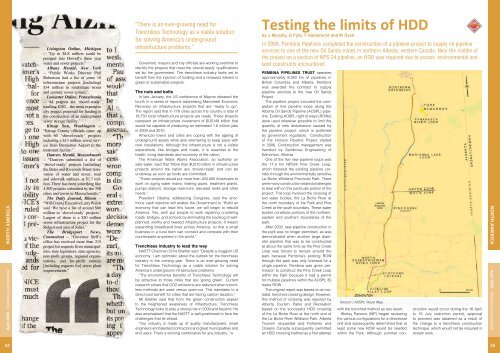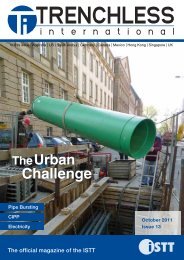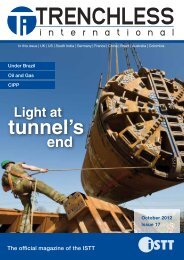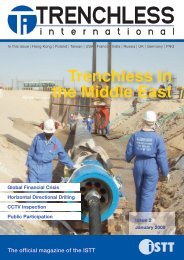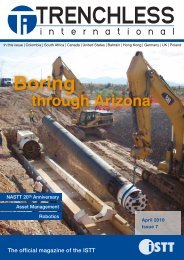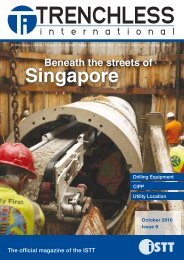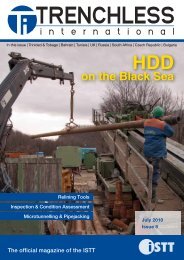North American Special - Trenchless International
North American Special - Trenchless International
North American Special - Trenchless International
Create successful ePaper yourself
Turn your PDF publications into a flip-book with our unique Google optimized e-Paper software.
north america<br />
April 2009 - <strong>Trenchless</strong> <strong>International</strong><br />
Livingston Online, Michigan<br />
– “Up to $4.8 million could be<br />
pumped into Howell’s three year<br />
water and sewer projects.”<br />
Albany Herald, New York<br />
– “Public Works Director Phil<br />
Robertson had a list of some 18<br />
infrastructure projects [including]<br />
$34 million to rehabilitate storm<br />
and sanitary sewer system.”<br />
Lancaster Online, Pennsylvania<br />
– “44 projects are ‘shovel-ready’<br />
totalling $262…the most expensive<br />
city project proposed for funding is<br />
the construction of an underground<br />
sewer storage facility.’<br />
Kitsap Sun, Washington –<br />
“Kitsap County officials came up<br />
with 60 ‘shovel-ready’ projects<br />
including a $13 million sewer service<br />
from Bremerton Airport to the<br />
treatment facility.”<br />
Danvers Herald, Massachusetts<br />
– “Danvers submitted a list of<br />
‘shovel-ready’ projects [including]<br />
the Bates and Riverside Street renovation<br />
of water and sewer, road<br />
and sidewalk surfaces, at $1.7 million.<br />
There has been something like<br />
4,500 projects submitted by the 350<br />
cities and towns in Massachusetts.”<br />
The Daily Journal, Illinois –<br />
“Will County Executive Larry Walsh<br />
said ‘We have a list of around $60<br />
million in ‘shovel-ready’ projects.’<br />
Largest of those is a $20 million<br />
sewer infrastructure project for the<br />
Ridgewood area of Joliet.”<br />
The Bridgeport News,<br />
Connecticut – “Governor Rell’s<br />
office has received more than 215<br />
project list requests from municipalities,<br />
state legislators, state agencies,<br />
non-profit groups, regional organisations,<br />
and for-profit entities<br />
[including requests for] sewer plant<br />
improvements.”<br />
“There is an ever-growing need for<br />
<strong>Trenchless</strong> Technology as a viable solution<br />
for solving America’s underground<br />
infrastructure problems.”<br />
Governors, mayors and city officials are working overtime to<br />
identify the projects that meet the ‘shovel-ready’ qualifications<br />
set by the government. The trenchless industry looks set to<br />
benefit from the injection of funding and a renewed interest in<br />
green or sustainable projects.<br />
The nuts and bolts<br />
In late January, the US conference of Mayors released the<br />
fourth in a series of reports addressing Mainstreet Economic<br />
Recovery on infrastructure projects that are “ready to go”.<br />
The report said that in 779 cities across the country a total of<br />
18,750 local infrastructure projects are ready. These projects<br />
represent an infrastructure investment of $US149 billion that<br />
would be capable of producing an estimated 1.6 million jobs<br />
in 2009 and 2010.<br />
<strong>American</strong> towns and cities are coping with the ageing of<br />
underground assets while also attempting to keep pace with<br />
new installations. Although the infrastructure is not a visible<br />
expenditure, like bridges and roads, it is essential to the<br />
health, living standards and economy of the nation.<br />
The <strong>American</strong> Water Works Association, an authority on<br />
safe water, said that “More than $US10 billion in infrastructure<br />
projects around the nation are ‘shovel-ready’ and can be<br />
underway as soon as funds are committed.<br />
“These projects would put more than 400,000 <strong>American</strong>s to<br />
work on aging water mains, leaking pipes, treatment plants,<br />
pumps stations, storage reservoirs, elevated tanks and other<br />
needs.”<br />
President Obama, addressing Congress, said the enormous<br />
cash injection will enable the Government to “Build an<br />
economy that can lead this future, we will begin to rebuild<br />
America. Yes, we’ll put people to work repairing crumbling<br />
roads, bridges, and schools by eliminating the backlog of wellplanned,<br />
worthy and needed infrastructure projects. It means<br />
expanding broadband lines across America, so that a small<br />
business in a rural town can connect and compete with their<br />
counterparts anywhere in the world.”<br />
<strong>Trenchless</strong> industry to lead the way<br />
NASTT Chairman Chris Brahler said “Despite a sluggish US<br />
economy, I am optimistic about the outlook for the trenchless<br />
industry in the coming year. There is an ever-growing need<br />
for <strong>Trenchless</strong> Technology as a viable solution for solving<br />
America’s underground infrastructure problems.<br />
“The environmental benefits of <strong>Trenchless</strong> Technology will<br />
be attractive to those cities that are ‘going green’. Current<br />
research shows that CO2 emissions are reduced when trenchless<br />
methods are used versus open-cut. This translates to a<br />
direct-cost benefit for cities that are facing carbon taxation.”<br />
Mr Brahler said that from the green construction aspect<br />
to the heightened awareness of infrastructure, <strong>Trenchless</strong><br />
Technology looks to play a strong role in 2009 and beyond. He<br />
also emphasised that the NASTT is well-positioned to face the<br />
challenges that lie ahead.<br />
“Our industry is made up of quality manufacturers, smart<br />
engineers and talented contractors and great municipalities and<br />
end users. That’s a winning combination for any industry.”<br />
Testing the limits of HDD<br />
by J Murphy, G Fyfe, T Giesbrecht and W Dyck<br />
In 2008, Pembina Pipelines completed the construction of a pipeline project to supply oil pipeline<br />
services to one of the new Oil Sands mines in northern Alberta, western Canada. Near the middle of<br />
the project on a section of NPS 24 pipeline, an HDD was required due to access, environmental and<br />
land constraints encountered.<br />
Pembina Pipelines Trust operates<br />
approximately 8,350 km of pipelines in<br />
British Columbia and Alberta. Pembina<br />
was awarded the contract to supply<br />
pipeline services to the new Oil Sands<br />
Project.<br />
The pipeline project included the completion<br />
of five pipeline loops along the<br />
Alberta Oil Sands Pipeline (AOSPL) pipeline.<br />
Existing AOSPL right of ways (ROWs)<br />
were used wherever possible to limit the<br />
quantity of new disturbance caused by<br />
the pipeline project, which is preferred<br />
by government regulators. Construction<br />
of the Horizon Pipeline Project started<br />
in 2006. Construction management was<br />
handled by Sambrosa Engineering of<br />
Edmonton, Alberta.<br />
One of the five new pipeline loops was<br />
the 17.3 km NPS24 Pine Creek Loop,<br />
which followed the existing pipeline corridor<br />
through the environmentally sensitive<br />
La Biche Wildland Provincial Park. There<br />
were many construction related challenges<br />
to deal with on this particular portion of the<br />
project. This loop involved the crossing of<br />
two water bodies, the La Biche River at<br />
the north boundary of the Park and Pine<br />
Creek at the south boundary. These water<br />
bodies constitute portions of the northern,<br />
eastern and southern boundaries of the<br />
park.<br />
After 2002, new pipeline construction in<br />
the park was no longer permitted, as was<br />
demonstrated when another large diameter<br />
pipeline that was to be constructed<br />
at about the same time as the Pine Creek<br />
Loop was forced to reroute around the<br />
park because Pembina's existing ROW<br />
through the park was only licensed for a<br />
single pipeline. Pembina was given permission<br />
to construct the Pine Creek Loop<br />
within the Park because it had a permit<br />
for multiple pipelines within the AOSPL 30<br />
metre ROW.<br />
The original report was based on an isolated,<br />
trenched crossing design. However,<br />
this method of crossing was rejected by<br />
Alberta Tourism, Parks and Recreation<br />
based on the successful HDD crossing<br />
of the La Biche River at the north end of<br />
the La Biche River Wildland Park. Alberta<br />
Tourism requested and Fisheries and<br />
Oceans Canada subsequently permitted<br />
an HDD crossing method as a first attempt<br />
Horizon / AOSPL Route Map.<br />
with the trenched method as last resort.<br />
Worley Parsons (WP) began reviewing<br />
the various configurations for a directional<br />
drill and subsequently determined that at<br />
least some new ROW would be needed<br />
within the Park. Although summer construction<br />
would occur during the 16 April<br />
to 15 July restriction period, approval<br />
to proceed was obtained as a result of<br />
the change to a trenchless construction<br />
technique, which would not be required in<br />
stream work.<br />
north america<br />
April 2009 - <strong>Trenchless</strong> <strong>International</strong><br />
52<br />
53


